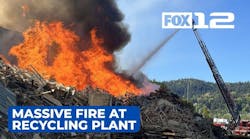ANCHORAGE (AP) -- The Sheenjek River Fire grew to 80,490 acres but firefighters say fire lines have kept the blaze away from Fort Yukon and some crews could be reassigned.
Crews have focused on the fire line nearest Fort Yukon and kept the blaze from jumping the Porcupine River, said fire information officer Kris Eriksen. The fire remains about eight miles from the community of 600 on the northern curve of the Yukon River 145 miles north of Fairbanks.
The fire started June 12 near the Sheenjek River.
Crews on Saturday targeted the northeast corner for the fire for controlled burns to keep flames from crossing the Sheenjek.
Eriksen said mop-up continued Sunday around the western end of the fire, the side closest to Fort Yukon. Firefighters watched for flames or smoke and pushed over trees with burned roots to prevent them from falling on crews.
''It's sort of the final cleanup stage,'' she said.
They also on Sunday burned out a pocket of unburned forest along the Porcupine River, Eriksen said, which will add to the total acres burned.
With the threat to the town diminished, firefighters pulled hose, supplies and gear from camps along the Porcupine and returned to Fort Yukon.
Eriksen said 261 firefighters were present Sunday but three Hotshot crews of 20 each were to leave Monday after working on the fire for two weeks. They could be reassigned there after a day off. Also, a crew of 16 from Venetie crew was reassigned to a fire at Beaver Creek, she said.
Firefighters Saturday conducted a controlled burn on the northeastern edge of the fire to keep it from jumping the Sheenjek River.
Crews used helicopters to fly low over treetops and drop incendiary devices that ignited ground cover. Pingpong balls containing potassium permanganate are loaded into a ''plastic sphere dispenser'' machine, Eriksen said. As they pass through machine, they are injected with glycol and dropped.
After about 20 seconds, the chemicals react and begin to burn.
Helicopters and scooper fixed-wing aircraft follow up to keep the fire from burning out of control.
''We only want it to burn so hot,'' Eriksen said.
Fire managers spent Sunday flying and evaluating other possible controlled burns.
The fire on the northern edge has been allowed to burn into the Yukon Flats National Wildlife Refuge, a 9.2 million acre area that has a separate fire management plan. The goal of the refuge is to protect or enhance habitat and ecosystems for fish and wildlife by letting naturally ignited fires burn.
The National Weather Service continued a dense smoke advisory through 6 a.m. Monday for Interior villages of Allakaket, Hughes, Bettles, Venetie, Central, Circle Stevens Village, Beaver, Chalkytsik, Birch Creek, and Circle Hot Springs as well as summits on the Steese Highway.
The advisory mean visibility was limited to a mile or less due to smoke.





